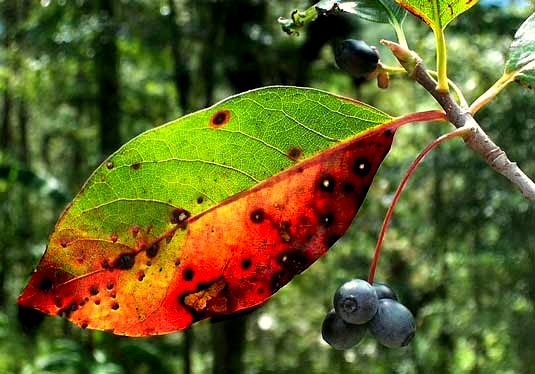Excerpts from Jim Conrad's
Naturalist Newsletter
from the October 29, 2007 Newsletter issued from Yerba Buena Clinic just outside Pueblo Nuevo Solistahuacan, Chiapas, MÉXICO
about 1740 meters in elevation, ± LAT. 17° 11' 27"N, LONG. -92° 53' 35"W
BLACKGUMS FRUITING
In Querétaro often I mentioned the mountaintop forests in which many relict species left over from the last Ice Age survive, where a dominant tree was North America's Sweetgum, Liquidambar styraciflua.
Here I'm living in just such a mountaintop "sky island" dominated by Sweetgums, along with many other species thought of as typical of eastern North American forests. The reason is the same as in Querétaro: When the last Ice Age's glacier withdrew, the North American species who had taken refuge at lower elevations at these latitudes could either follow the cool weather back north, or go up in elevation. Either way they'd remain in the cool climate they needed.
Despite being much farther from North America than was Querétaro, our Chiapas sky-island forests have just as many species typical of North America's eastern forests as did Querétaro. In fact, because it's rainier here, the forests are lusher and maybe there are even more North American species.
One such relict species very common and conspicuous here is the Blackgum, also called Black Tupelo, NYSSA SYLVATICA. It's fruiting now, as you can see below.

Though the leaf in that picture is fallishly red, hardly any other leaves in our forest are anything but green. We're still in the rainy season here and things are as green as Kentucky in June. However, Black Tupelos are among the very first trees to show a red leaf or two in advance of fall, so it won't be long until the rainy season ends and our trees become more colorful, maybe even lose some leaves.
Note the black spots on the leaf in the photo. Surely they're fungal in nature. Such spots are very typical on leaves of North American trees as well. I'm thinking that when the Black Tupelo species migrated south during the last ice age it brought with it this fungus.
What a pleasure seeing Black Tupelos here. When I was a kid on the Kentucky farm each morning I awaited the school bus beneath two big Black Tupelos, one male and one female. It's a shame the pretty, juicy fruits are so bitter. However, you can imagine how birds love them.